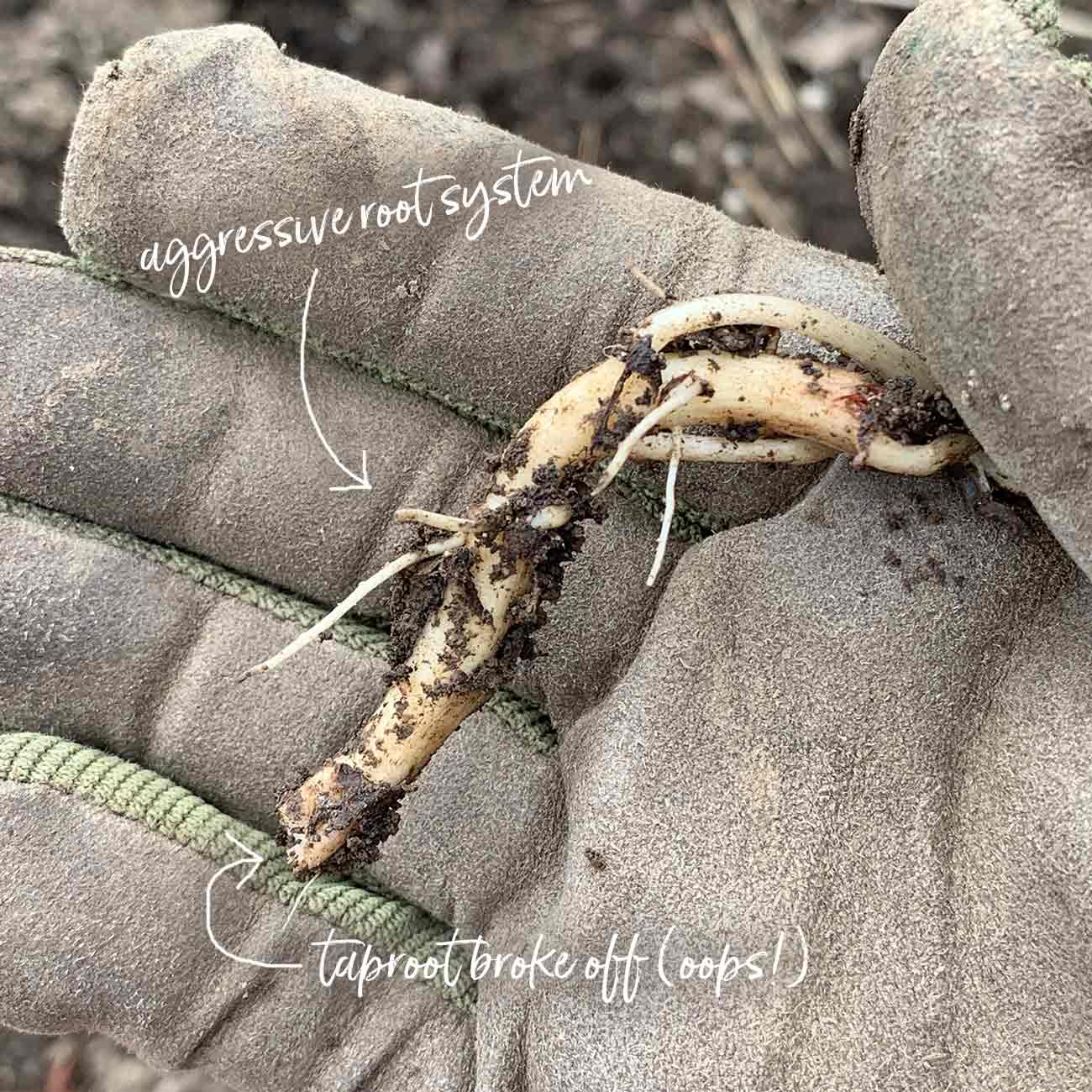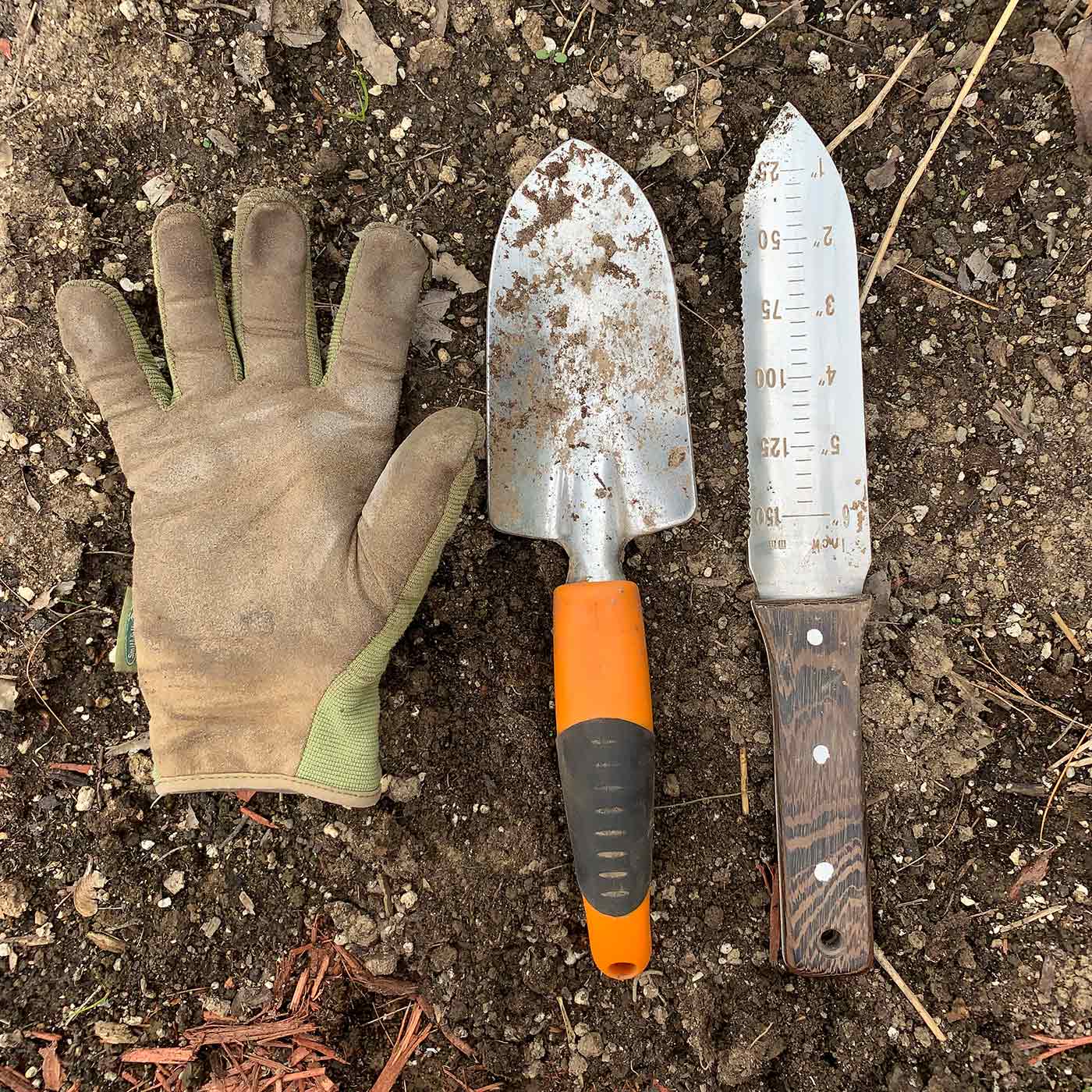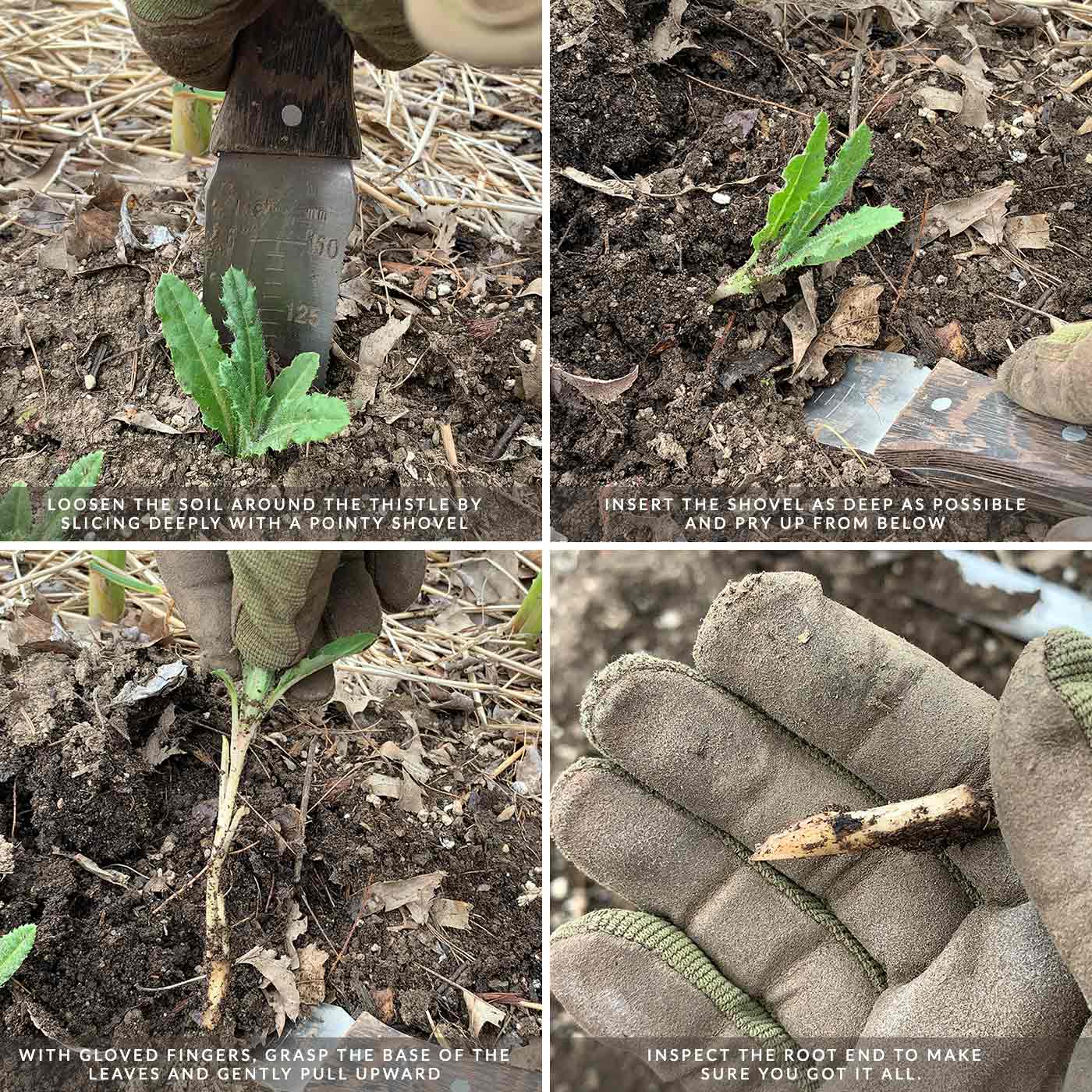Thistle is one determined gardening foe. Learn how to get rid of thistle and the best way to control thistles in your garden without resorting to scorching the earth with chemicals.

There’s just no easy way to say this, my gardening friends: An invasion of thistle in your vegetable garden is bad news.
It’s an unpleasant plant in general, not particularly attractive, and rimmed with numerous, slender spines that are painful when touched.
But, far beyond aesthetics, a thistle invasion means a long-term relationship with this noxious weed. Its survival game is on point and can generally outwit, outplay, and outlast any effort and exuberant determination we’re willing to spend on it.
So, the bad news is not just the invasion, but the whole war: it will take a season of staying on top of every outbreak, with a consistent weeding schedule: at least once a week, and after every rainy period.
How Does Thistle Spread?
Thistle is a very successful plant primarily because it’s extremely efficient at propagation. Like many invasive plants, it does, indeed, produce flowers and eventually seeds which will produce new plants when sown, whether by wind or humans, or even birds.
However, that’s not its one and only method. In fact, it’s not even its best method. No, thistle spreads most aggressively through its extraordinary root system.

Thistle first drops a thick and quick-growing taproot when the plant is only days old. From there, while the taproot continues drilling down into the soil, it sends out lateral shoots, which spread out from the plant like a web. These lateral shoots grow very long, in all directions, developing buds at nodes along their lengths, which can, in turn, produce more plants.
So, you can imagine the effect if you simply yank the plant out the ground: it breaks off at the taproot, and it also breaks off at all of those lateral points, which have the ability to regenerate into another plant.
Finally, the taproot is interestingly both sturdy and fragile. It drives relentlessly downward, with the goal of establishing a firm grip in the ground, as well as sends out shoots whenever possible.
It’s frustratingly difficult to cleanly free even a medium-young plant from the ground: the tip of the root breaks off easily, leaving behind just enough material to regenerate the plant underground.
Tilling, which is often an effective means of disrupting the growth of other invasive plants, has the opposite effect with thistle: it simply spreads the root pieces around the garden, where they will re-establish and grow.
Why Not Get Rid of Thistle with Herbicides?
If you’ve googled this topic, you’ve no doubt read the recommendations to apply herbicides such glyphosate. And truth be told, that’s the best way to kill thistle: till deeply – more deeply than the average home gardener’s tiller can manage – and then spray the entire land with a plant-killing herbicide, to abolish the root pieces broken up and buried by the tilling process.
But, as an organic gardener, I have numerous problems with this solution. Such an herbicide is going exactly nowhere near my organic vegetable garden, and unless you specifically combine the herbicide application with a deep-root-disrupting tillage, the herbicide isn’t going to be effective anyway.
This a bit of a scorched earth approach, and I cannot, in good conscience, recommend it.
Don’t be lulled into believing that you can selectively apply an herbicide to the plant only to solve the problem. The herbicide will, indeed, kill the greenery above ground, but very likely not the root.
Tools For Removing Thistle
You likely already have all you need to deal with a thistle invasion:

- A heavy glove for your dominant hand, preferably with thick suede palms and fingers, to protect your hand from thistle’s numerous and thin thorns.
- A sturdy hand shovel with a pointy tip and a long blade.
- A garden knife with a long blade (optional – can be used in place of the hand shovel).
How to Dig Up Thistle
The goal of banishing thistle from your garden is to, of course, remove the plant in its entirety. Which is easier said than done, given the previous description of their root system.
So, the best way is to attack the plants is while they’re young and have get-at-able root systems.

- With your shovel or garden knife, slice straight down into the soil, about two inches away from the plant.
- If the soil is nice and loose, you’ll probably be able to skip to the next step of prying, but if the ground is tight and compact, make another slice or two around the plant in a circle.
- Insert the shovel or knife again, deeply, and slowly pry the soil up from underneath the plant. It will likely not free itself from the ground yet.
- When the plant has clearly been destabilized from its foundation, grasp the base of the leaves with a gloved hand and gently begin pulling straight upward.
- The taproot is thick, and you’ll be able to sense resistance as you pull. If the root feels like it’s stubbornly holding onto the earth, release your grip, go in more deeply with the shovel, and try again until freed.
- Continue digging out each thistle individually. It will quickly become muscle-memory, and you’ll be able to clear a plant in 15 seconds or so.
If you hear a distinct “snap” while pulling on the plant, kind of like breaking pretzel stick in half, that’s probably the root breaking off. Inevitably, this will happen, especially with older plants with long, thick roots.
If you have room amongst your wanted plants in the garden, you can go hunting for the snapped off root by digging deeper.

Controlling Thistle in the Long Term
Managing a thistle invasion is an ongoing prospect. You can clear a plot of thistle, only to have it pop back up later on the outskirts, thanks to stray roots.
One of the best non-chemical ways to manage a cleared area in your vegetable garden is lay down a weed blocking or landscaping fabric. Depending on what you’re growing, you can cover the entire garden and cut holes in the fabric to accommodate what you’re growing (say, pepper plants or zucchini or onions).
Or, if you need more sections of exposed soil, place the cloth in walking pathways and between rows of crops. Anything to reduce the amount of exposed soil that you have to keep an eagle eye on. Some thistle might still break through the cloth, but the larger area you can block, the less opportunity the thistle will have to break through to the sun and establish a new plant.
The community garden where I have a plot or two had a thistle invasion some years ago. It took several seasons of diligent weeding to get it under control. The photos from this post were taken at that community garden, so, you can see that it’s still an ongoing situation. The challenge there is that not every garden participant is as committed to weeding as we’d like, so, we’ll probably never be rid of it completely. But it’s manageable with a few minutes of digging every week.



 Welcome! I'm Karen, Chief Gardener, Tool Cleaner, Tomato Pruner, and Cabbage Worm Picker-Offer.
Welcome! I'm Karen, Chief Gardener, Tool Cleaner, Tomato Pruner, and Cabbage Worm Picker-Offer.
Leave a Reply